Background
- Modern multicultural environment requires improved health policies;
- Links between health policies’ promotion and financial, social, and legal factors must be identified; thus, successful reinforcement of health policies will be possible.
Over the past few years, a multidimensional model has been integrated into health policies (Costa et al., 2016). The specified tool allows meeting the Healthy People 2020 objectives and encouraging patient education for faster detection of health concerns (Kolbe, Allensworth, Potts-Datema, & White, 2015). The introduction of a flexible framework for handling the issue is strongly recommended. It is paramount to understand the connection between the promotion of health and social, economic, legal, and financial factors.
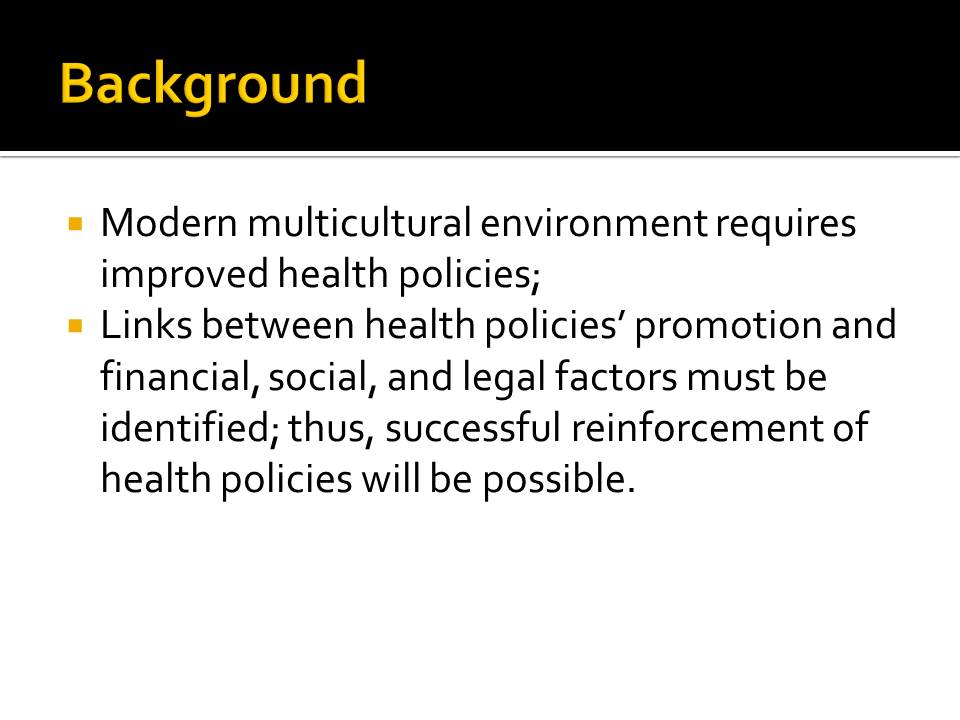
Health Policies: Description, Objectives, and Key Components
- Instructions for health organization;
- Focus on improving patient outcomes;
- Promotion of patient education;
- Active use of communication.
Thus, when considering current health policies, one must admit that most of them revolve around patient education and enhancement of communication between patients and nurses, as well as the increase in community collaboration (Kolbe et al., 2015).
In addition, the emphasis on nurse education has been placed. As a result, opportunities for the consistent improvement of the quality of care have been created. Nevertheless, a further analysis of the subject matter is needed to meet the needs of the multicultural population.
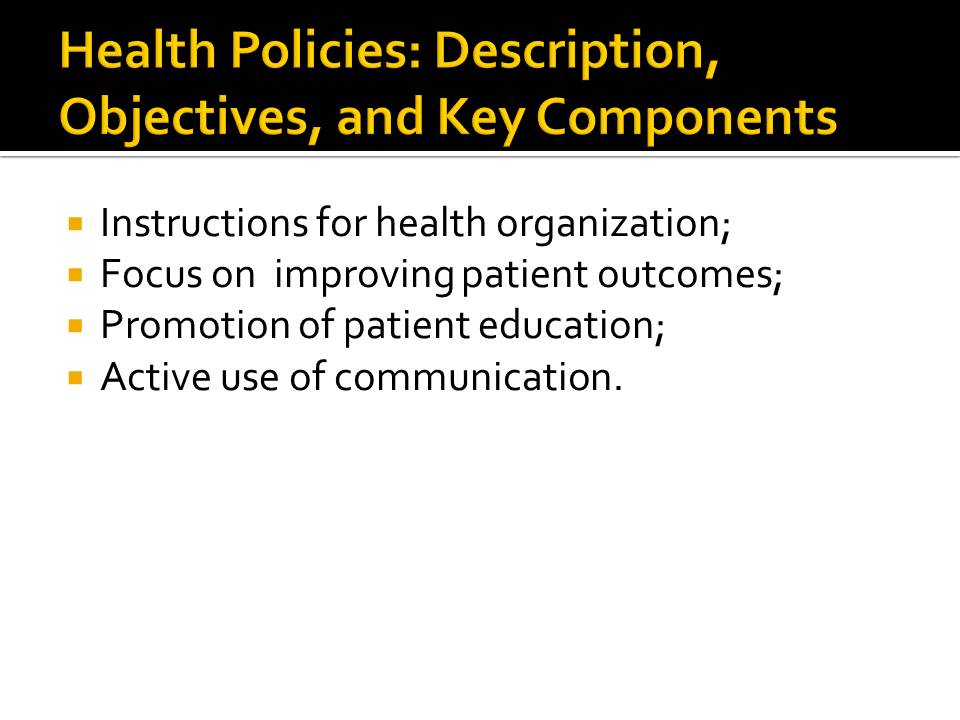
Health Policies: Examples
- Identification of threats related to the climate change;
- Analysis of the existing policies;
- Focus on environmental issues;
- Examples: healthcare for immigrants, multicultural communities, etc.
The standards aimed at addressing the needs of immigrants in the context of the U.S. healthcare environment can be regarded as an example of a health policy. The specified regulation provides opportunities for health coverage for immigrants and extensive opportunities for their children to receive appropriate help. The policy also addresses the scenarios in which immigrants may be denied public charge opportunities and even be deported (National Institute of Health, 2018). As a rule, a typical health policy incorporates evidence-based guidelines for a specific demographic. For instance, the Health in All Policies (HiAP) is aimed at addressing the needs of people in the context of the climate change (Florida Institute for Health Innovation, n.d.).
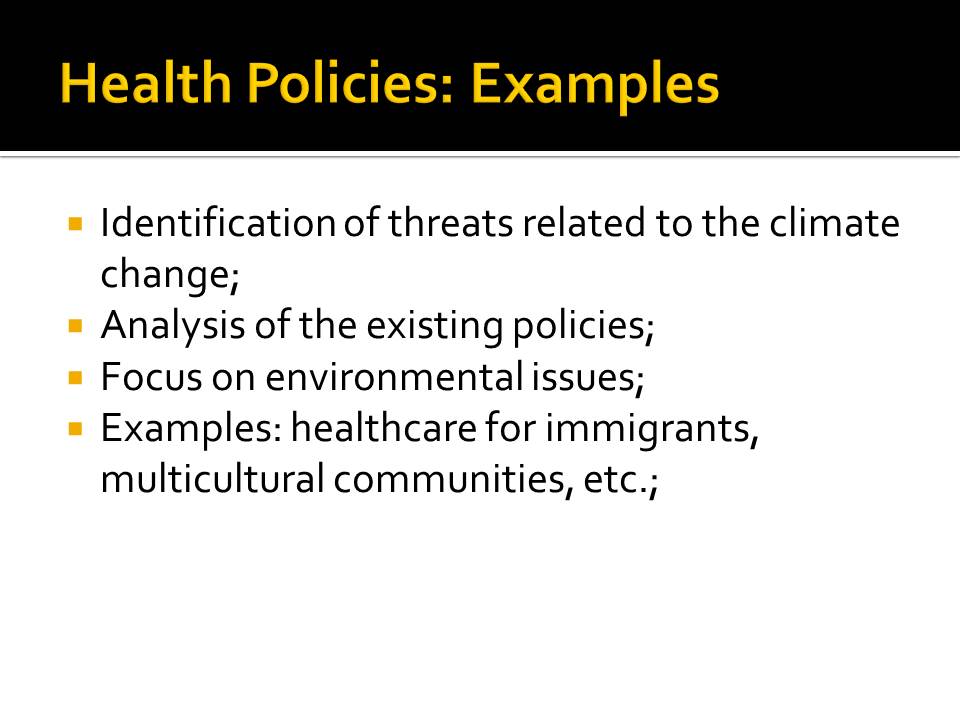
Health Policies and Legislation: Framework
- Motivation for policy change;
- Emergence of health concerns;
- Pressure from media;
- Objectives and stakeholders identified;
- Pre-legislative evaluation and transparency promotion;
- Decision-making at the Dept. level.
The connection between health policies and legislation are quite obvious. To alter current health standards and guidelines, one must consider changing the legal requirements, such as the redesign of health insurance standards, etc. For this purpose, the current legal standards regarding health promotion have to be scrutinized, key stakeholders must be identified, and the changes must be introduced at the Department of Health level. Thus, health policies will be incorporated into the existing legal framework successfully. Furthermore, the identified process will require the enhancement of transparency within the related healthcare processes to ensure that the needs of all stakeholders are met respectively (National Institute of Health, 2018).
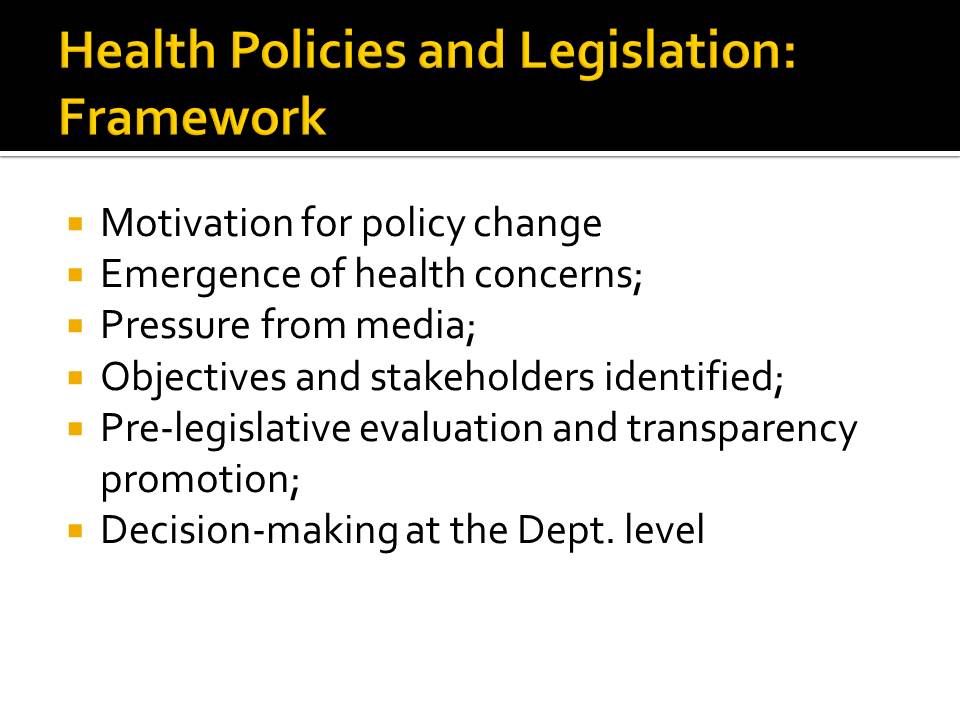
Health Policies and Legislation: Connections
Coherent health policies and information management:
- Legal standards;
- Patient education;
- Technology;
- Communication.
As stressed above, the key links between health policies and legislation concern the need to introduce changes necessary to sustain health of target demographics at the state level. Therefore, legislation defines the success of promoting health policies by outlining the standards for providing appropriate health services and determining limitations thereof. The redesign of health policies, in turn, may affect the current legislation by prompting a change that will allow improving the quality of provided health services. Thus, the connection is reciprocal between the two.
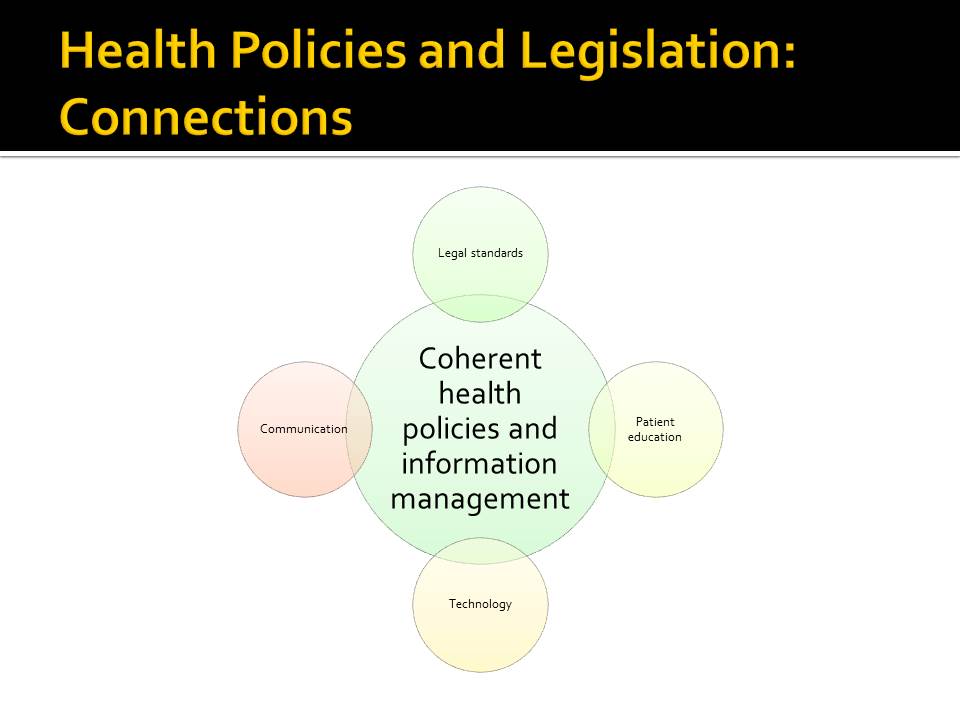
Health Policies and Legislation: Examples
- Telehealth: opportunities for tracking changes in patients’ well-being;
- Requires change in the current legislation;
- Basic changes have been introduced;
- However, still no agreement on the boundaries of the control.
When exploring the examples of how current legislation affects the enactment of health policies and their successful implementation, as well as how a change in health policies may spark alterations in legal standards, one should consider the introduction of the concept telehealth into the health management and promotion framework (Papanagnou, Candidate, Sicks, & Hollander, 2015). The legal standards for tracking patients’ well-being were introduced as a response to the need to monitor changes in patients’ health as they are released from hospitals (Papanagnou et al., 2015). The impact of legal requirements on the health policy is also evident since the regulations for the adoption of Telehealth-based techniques require complying with the standards for prescribed controlled substances. Furthermore, the connection between the two concepts is reflected in the lack of agreement about what is allowable.

Health Policies, Legislation, and Regulations: Links
- Identification of needs;
- Location of communication tools;
- Assessment of key factors;
- Evaluation of regulations;
- Detection of obstacles and opportunities;
- Introduction of changes to legislation;
- Use of regulations to reinforce health policies;
- Introduction of monitoring tools;
- Gathering feedback and assessing outcomes.
The process of introducing changes into the realm of healthcare through regulations is linked directly to health policies and the legislation. Particularly, the focus on the implementation of health policies in the target environment can be deemed as the ultimate reason for connecting healthcare policies to regulations. The use of regulations allows adjusting health policies so that they could fit the context of a particular community and, thus, meet the needs of their target population most successfully.
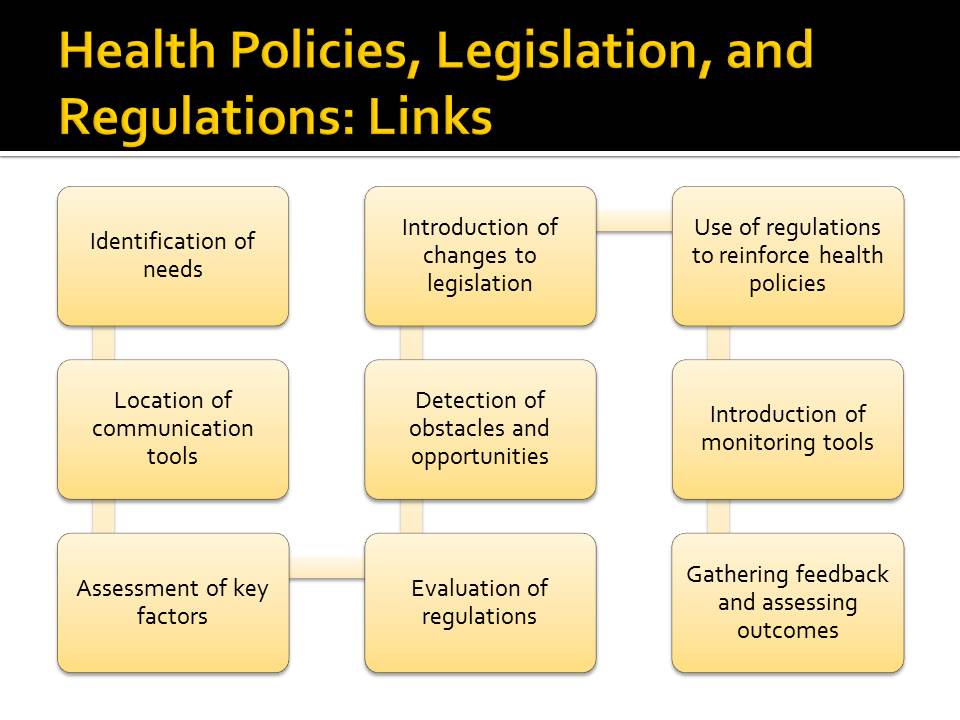
Health Policies, Legislation, and Regulations: Management
- Elaborate information management approach;
- Focus on patients’ security;
- Tools for enhancing patients’ data security.
Patient security Policy:
- Risk analysis;
- Staff training;
- Patient communication.
The implementation of changes in the legislation standards as far as the issue of healthcare is concerned is also fraught with numerous difficulties. For instance, the enactment of the health policy aimed at addressing the issue of patients’ personal data protection requires the introduction of tools for enhancing data security within the environment of a particular facility. As a result, instructions concerning the management of patients’ information, particularly, its acquisition, storage, and further transfer between the members of the facility must be regulated in accordance with the principles aimed at reinforcing data security (e.g., providing instructions concerning the use of passwords).

Health Policies, Legislation: and Regulations: Quality and Control
- Affordable Care Act: data safety regulations;
- Necessity to maintain quality according to regulations;
- AAC linked closely to HIPAA.
Exploring the examples of regulations being used to implement health policies based on the existing legal standards, one may consider the Affordable Care Act (AAC). Particularly, the enactment of AAC demanded to comply with the principles of personal data safety as stated implicitly in the U.S. Constitution (Park et al., 2015). Thus, the HIPAA Privacy Rule as the core regulation standard for addressing the specified issue was introduced into the framework.
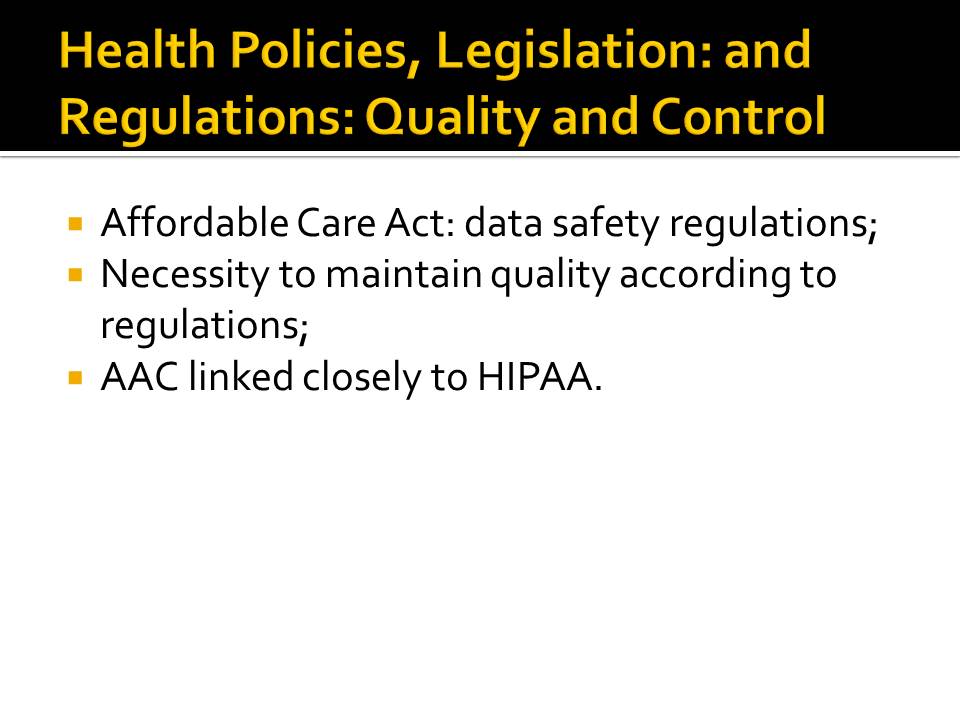
Health Policies, Legislation: and Regulations: Examples
- FDA as the foundation for promoting Centers for Medicare and Medicaid Services;
- Tight focus on patients’ personal data as the basis for providing healthcare services;
- Legal standards determining the use of the policy.
The introduction of FDA-approved strategies into the realm of the Centers for Medicare and Medicaid Services as the means of improving the quality of data transfer to prevent the misuse of patients’ personal information can be viewed as an example of a regulation being implemented in a healthcare setting based on a legal change encouraged by alterations in healthcare policies (Rajaram et al., 2015).
The issues associated with finance are linked directly to the introduction of new health policies into the realm of multicultural communities. Apart from the expenses required to manage the policies, one will also have to consider investing in the enhancement of patient education and in the strategies for raising awareness among target populations. Consequently, the link between finances and the introduction of health policies into the environment of a particular community is explicit. Financial processes are supposed to be aimed at maintaining equity in health and finance, at the same time promoting responsiveness.
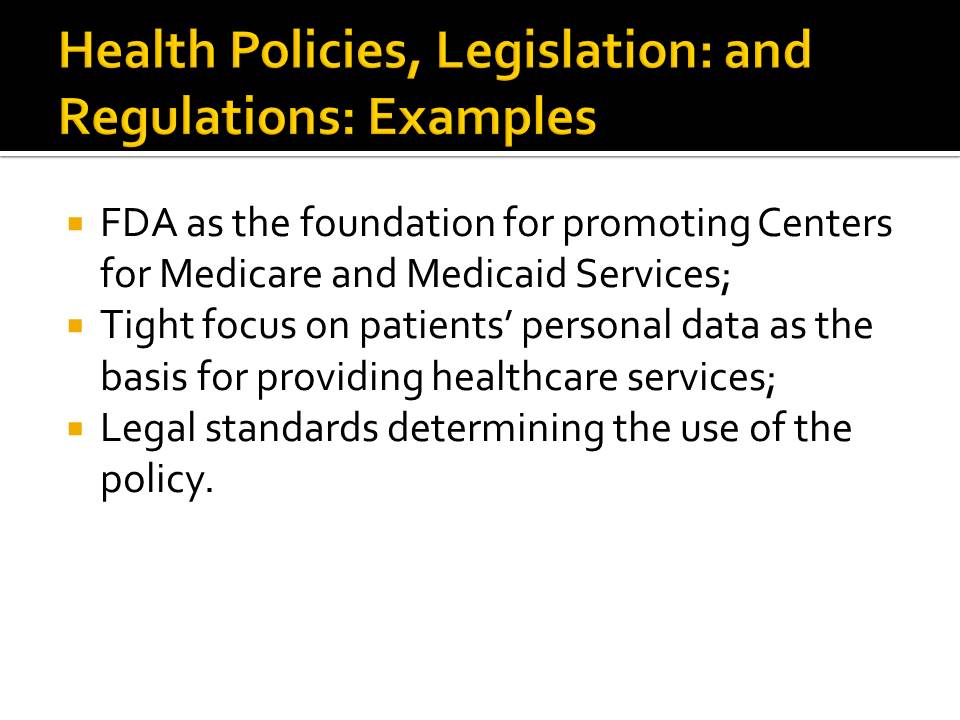
Health Policies, Legislation, Regulations, and Finance
- Waste reduction;
- Sustainable resources usage;
- Lean management;
- Cost-efficient policies.
Inputs:
- Staff;
- Logistics;
- Leaders.
Processes:
- Nurse training;
- Patient education;
- Lean manageemnt.
Outputs:
- Energency response;
- Public health services.
Outcomes:
- Improved healthcare system;
- Increase inpositive patient outcomes;
Impact:
- Public health improvement.
As the diagram above shows, the process of introducing healthcare policies in the realm of a particular community requires the introduction of a particular revenue stream that will allow for fast and efficient management of the available financial resources, particularly, their use for improving healthcare services and meeting the needs of target demographics. Therefore, it is crucial to introduce the principles of management based on the sustainable use of financial resources and lean approaches toward waste management.
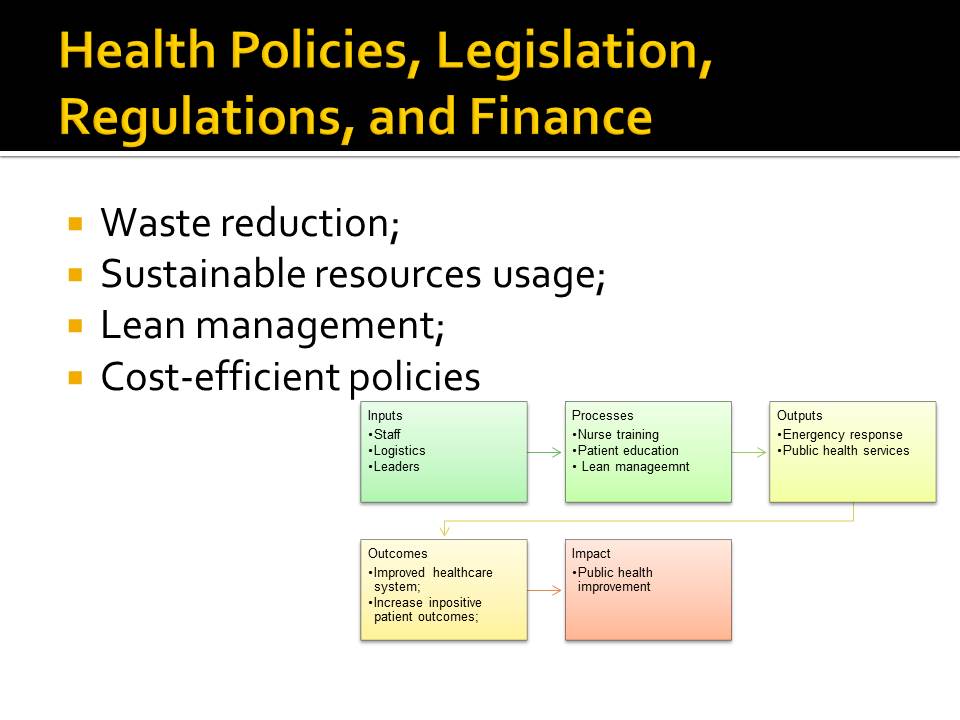
Health Policies, Legislation, Regulations, and Finance: Risk Management
- Focusing on the active use of cost-efficient strategies;
- Handling possible HRM-related issues (e.g., an employee’s sick leave);
- Linking changes in values and vision to new financial policies.
Addressing financial risks is a crucial step toward reinforcing the efficacy of the selected financial model. Therefore, a healthcare organization must consider utilizing the available strategies for reducing costs. The specified task concerns not only the management of external expenses but also the issues that may occur within an organization (e.g., an employee’s long-term leave). Furthermore, the change in the corporate financial policies is linked directly to the change in the organization’s values and vision, which is closely related to the redesign of health policies.

Health Policies, Legislation, Regulations, and Finance: Integrating Innovative Approaches
- Necessity to control financial operations in the healthcare setting;
- Technology as the means of enhancing the connection between health policies, legislation, regulations, and finance;
- Close connection between health policies, their values, and the ethical possibility of a financial fraud.
It is strongly recommended to integrate technology in the process of maintaining the connection between health policies, their legislation and regulation, and the introduction of innovative financial approaches. Particularly, the adoption of a control and measurement system based on the following framework is required: inputs and processes – outputs – outcomes – impact (Centers for Disease Control and Prevention, 2017).
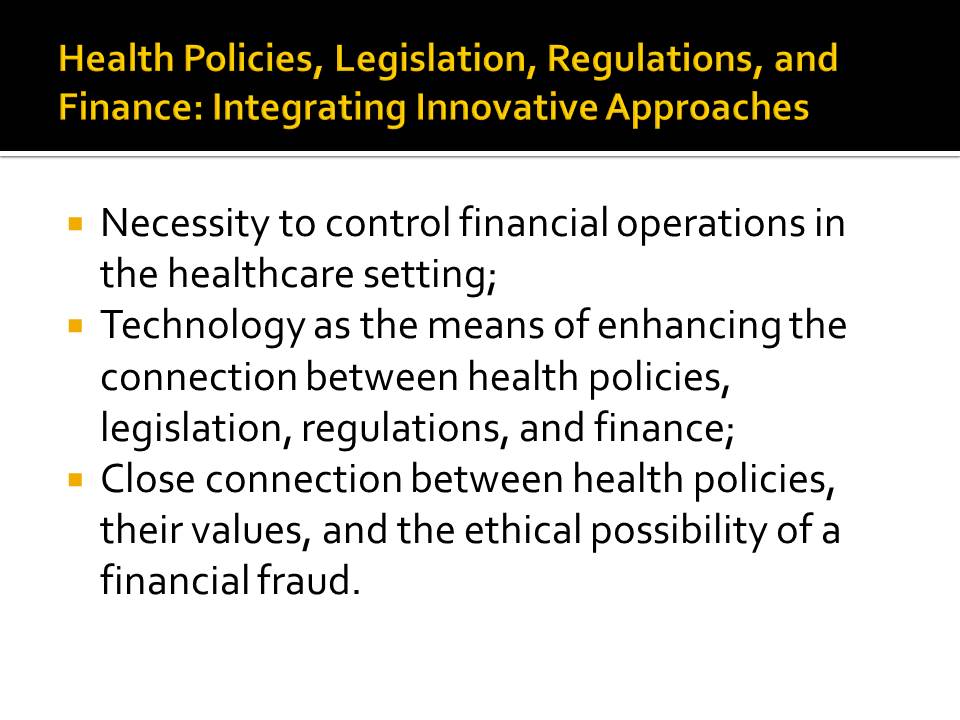
Health Policies, Legislation, Regulations, and Finance: Examples
- Possibility of health policies depending on the financial environment;
- Tight connection between health policies and financial approaches;
- Need to use legal standards to support financial choices.
The question whether a health policy must be grounded in the financial issues associated with it can be regarded as the prime example of the interconnection between the specified two variables. Seeing that the processes of regulating the policy and introducing changes into the legal system are fraught with significant expenditures as well, it can be stated that there is a direct link between health policies, legislation, regulation, and financial management strategies.
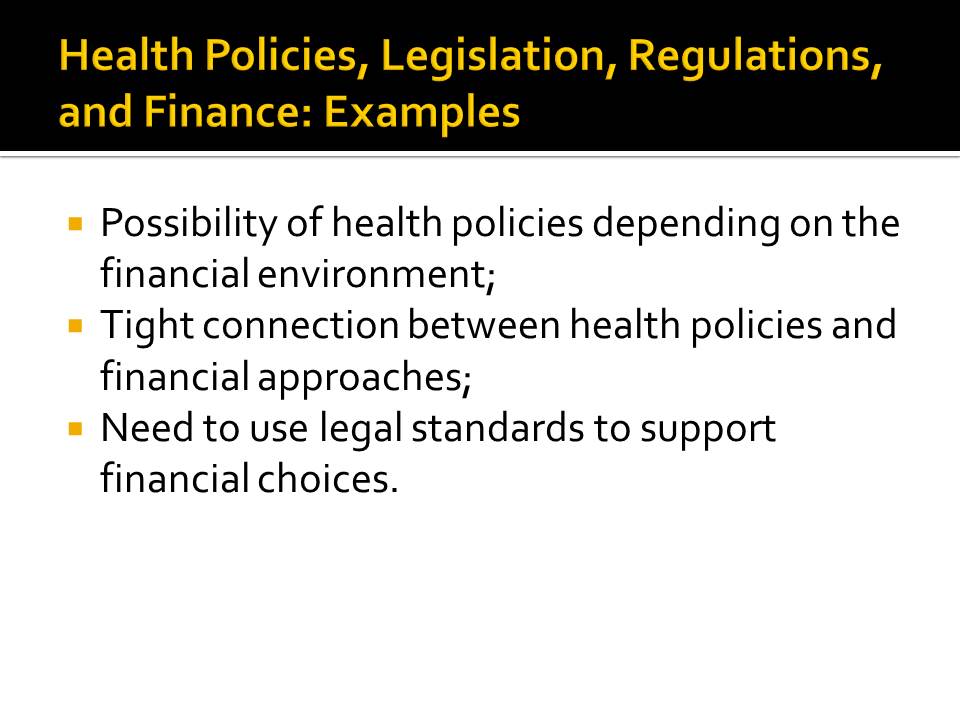
Health Policies, Legislation, Regulations, Finance, and Practice: Connections
A combination of social and political sustainability along with the consistent financial support should be viewed as the basis for integrating a health policy successfully into the realm of a particular community. Therefore, the practical implementation of health policies hinges on the specific legal system that operates in the selected region, the regulations that are viewed as crucial in the target area, and the financial strategies that can be used to enhance the efficacy of newly adopted health policies.
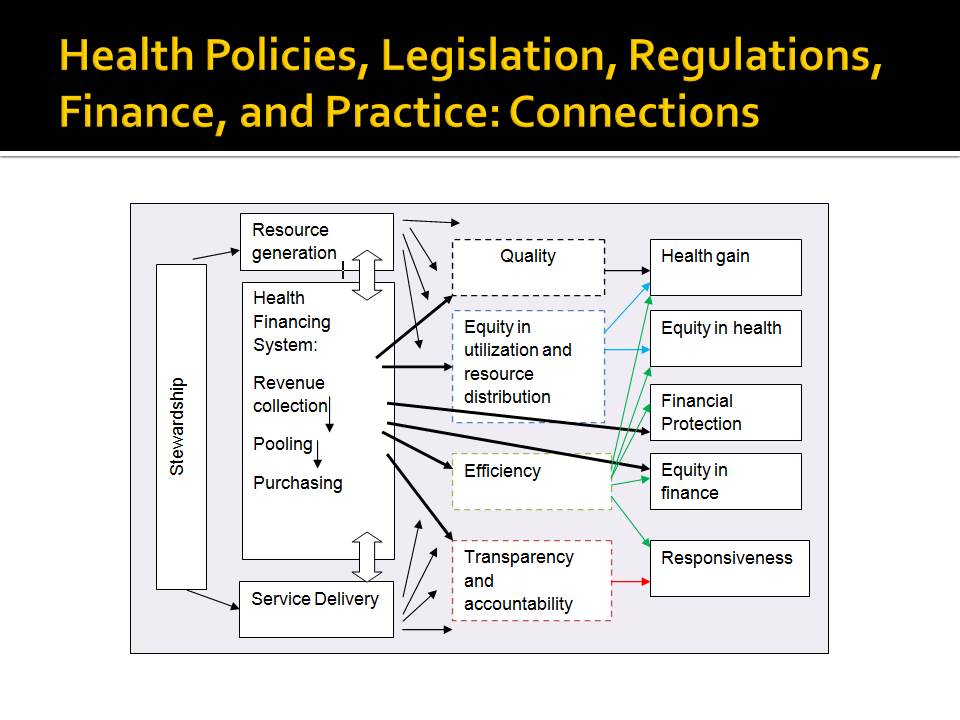
Health Policies, Legislation, Regulations, Finance, and Practice: Communication Concerns
- Possible issues with data transfer;
- Necessity to enhance security;
- Need to engage in a multicultural dialogue;
- Focus on patient and nurse education.
It should be borne in mind that the application of newly developed health policies and the provision of the necessary services may be fraught with difficulties associated with communication and data transfer. The process will also require the reconsideration of the existing communication framework by reinforcing the importance of patient education and creating opportunities for establishing a link between healthcare organizations and communities. As a result, the efficient implementation of health policies will become a possibility. Otherwise, the suggested policies will not be integrated into the community system, even though being represented at the legal and regulation-related levels.

Health Policies, Legislation, Regulations, Finance, and Practice: Examples
- Need to focus on human rights;
- Necessity to provide healthcare to all demographics;
- Management of needs among the residents of remote areas with the help of innovative technologies.
Considering the examples of health policies being linked directly to legislation, regulations, financial strategies, and practice, one may need to take a closer look at some of the innovative solutions in contemporary healthcare. For instance, the recent emphasis on the necessity to meet the human rights of every single citizen and, therefore, provide efficient healthcare to the residents of remote areas has been considered recently a priority (Hilten, 2015). In addition, my personal experiences also point to the interconnection between health policies, regulations, legislation, finance, and practice. For instance, the necessity to alter the service delivery model toward a consistent rise in flexibility.
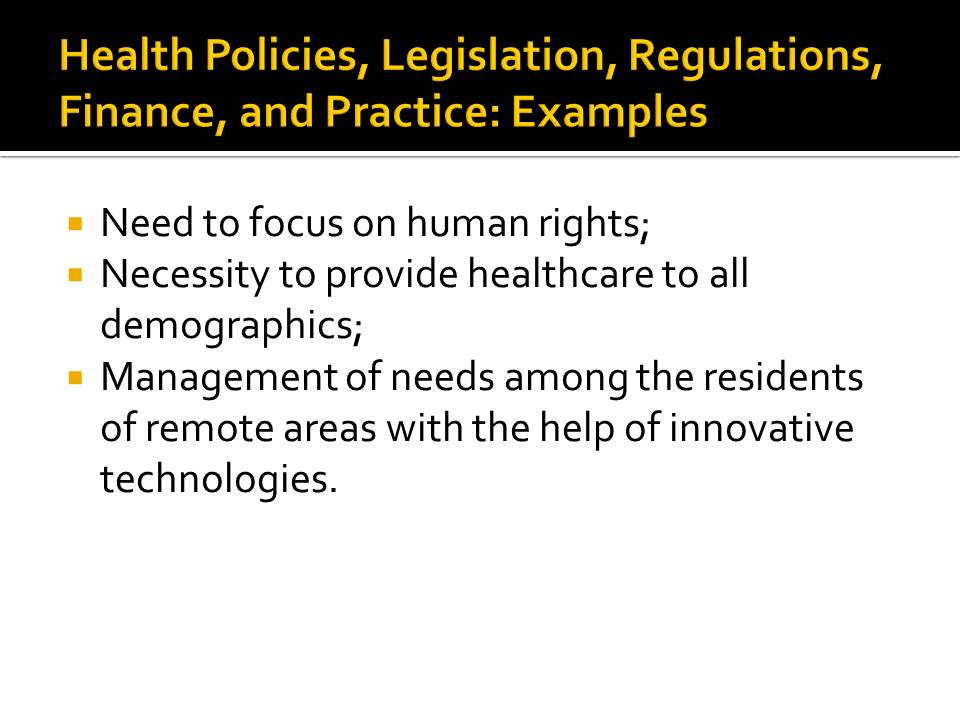
Recommendations
- Detailed analysis of the target environment and cultural specifics of local communities;
- Identification of legal issues that may impede the process of health policies promotion;
- Identification of crucial regulations that will help introduce the policy;
- Location of the available financial resources and design of an elaborate finance risk management policy;
- Integration of the existing communication tools for reaching out to the community members and implementing the policy accordingly.
It is strongly advised that implementation of health policies should start with the analysis of the environment in which it will be implemented. Afterward, the enhancement of communication techniques and information management systems is needed to facilitate a complete integration of the suggested innovative techniques into the community. The specified step will entail the following successful enhancement of patient education, thus, raising the levels of awareness and contributing to a rapid increase in positive patient outcomes. The promotion of health policies, therefore, requires the development of programs aimed at building awareness among target demographics and increasing the levels of patient education by reinforcing the efficacy of a patient-nurse communication (Park et al., 2015).
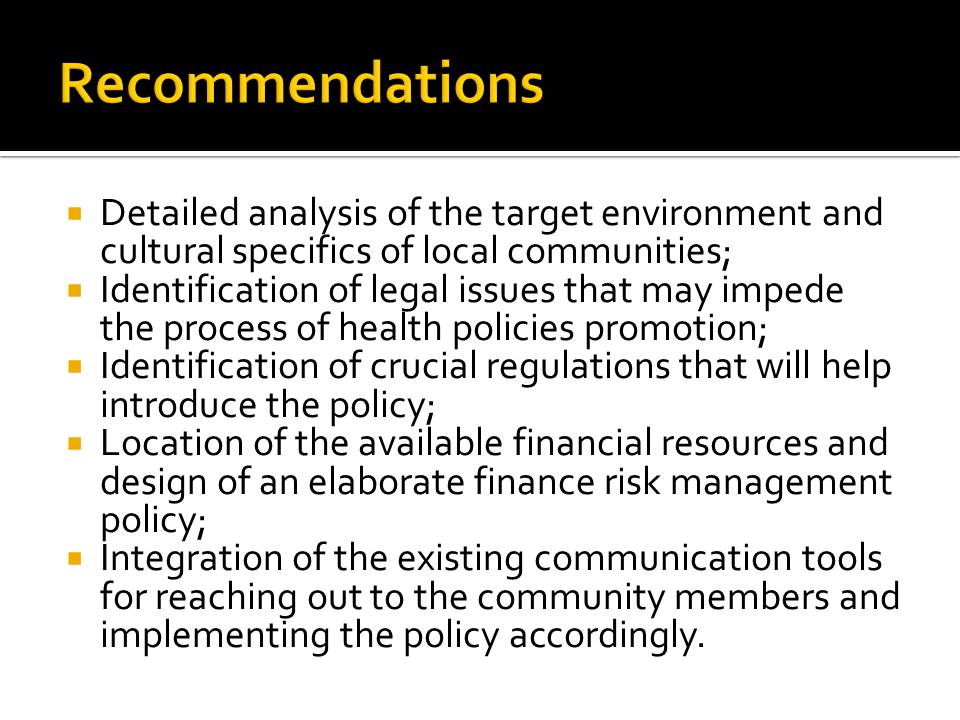
Conclusion
- Health policies are linked closely to legislation, regulation, finances, and practice-related obstacles;
- To implement health policies successfully, one needs to take the specified issues in consideration;
- Communication enhancement must be deemed as paramount to the efficacy of health policies’ integration into communities.
Introducing new health policies is a crucial step toward improving the quality of patients’ lives and addressing their health concerns. However, to implement a health policy successfully within the realm of a particular community, one must consider connecting it to the concepts such as legislation, regulations, finance, and possible practice-related obstacles, e.g., communication barriers. Once the specified elements are incorporated into the framework, a health policy can be put into practice and used to improve patient outcomes within a particular setting.
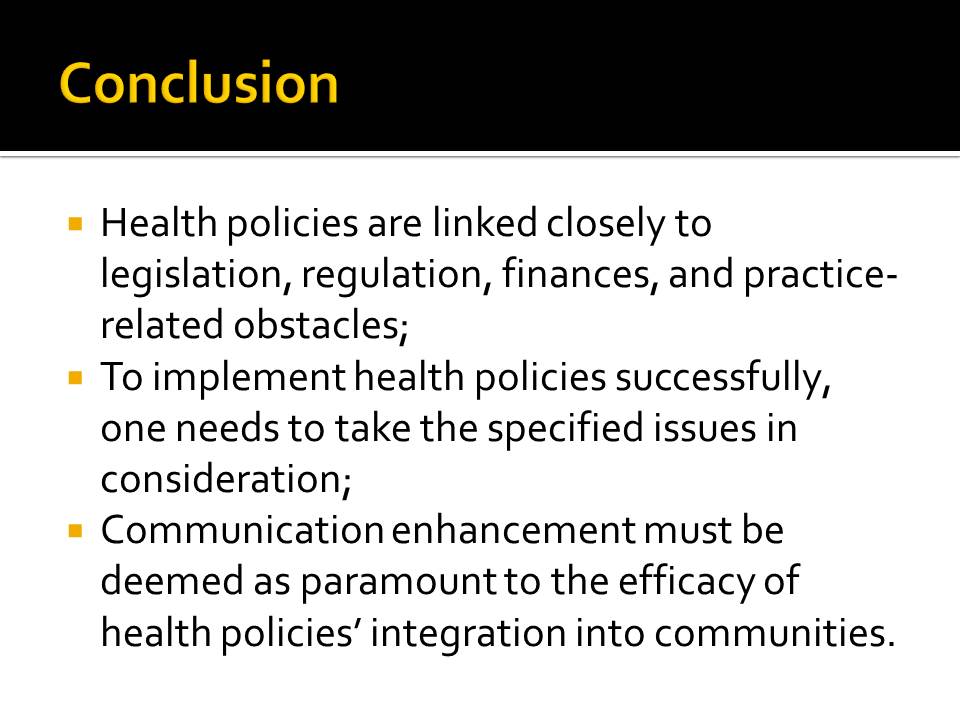
References
Centers for Disease Control and Prevention. (2017). FETP logic model. Web.
Costa, A. B., Pase, P. F., de Camargo, E. S., Guaranha, C., Caetano, A. H., Kveller, D., … Nardi, H. C. (2016). Effectiveness of a multidimensional web-based intervention program to change Brazilian health practitioners’ attitudes toward the lesbian, gay, bisexual and transgender population. Journal of Health Psychology, 21(3), 356-368.
Florida Institute for Health Innovation. (n.d.). Health in all policies. Web.
Hilten, L. G. V. (2015). Health care policy should not focus on finance, says research. Web.
Kolbe, L. J., Allensworth, D. D., Potts‐Datema, W., & White, D. R. (2015). What have we learned from collaborative partnerships to concomitantly improve both education and health? Journal of School Health, 85(11), 766-774.
National Institute of Health. (2018). Proposed changes to “public charge” policies for immigrants: Implications for health coverage. Web.